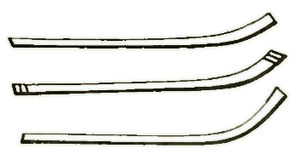This page has been validated.
Offensive Weapons.
The club or waddy called by the natives of the River Yarra Kud-jee-run or Kud-jer-oong is used mostly in single combat, when both combatants are provided with the strong shield (Mulga).[1] Blows are aimed at the head only with this weapon. To strike at any other part would be deemed unfair. It is a heavy and strong weapon, and is made of the Burgan (mountain tea-tree, Kunzea peduncularis), or box or red-gum (Eucalyptus rostrata).

|
| FIG. 56.—(Scale 1/10.) |
Figs. 56 and 57 are common forms of the club. This club is called by some of the men of the Murray Koom-bah-mallee.
- ↑ The figures on the Egyptian monuments would lead one to suppose that the weapons used by the allies of the Egyptians were not very different from those made by the Australians, as shown in this work. In an engraving in Wilkinson's Ancient Egyptians, one of the allies is represented as carrying a club somewhat similar to the Kud-jer-oong.
And speaking of the Egyptians, Wilkinson says:—"A club has also been found and is now in the British Museum, armed with wooden teeth, similar to those in the South Sea Islands; but it was probably of some rude, foreign people, and is not represented on the monuments.
"In ancient times, when the fate of a battle was frequently decided by personal valour, the dexterous management of such arms was of great importance; and a band of resolute veterans, headed by a gallant chief, spread dismay among the ranks of an enemy. They had another kind of mace, sometimes of uniform thickness through its whole length, sometimes broader at the upper end, without either the ball or guard; and many of their allies carried a rude, heavy club; but no body of native troops was armed with this last, and it cannot be considered an Egyptian weapon.
"The curved stick or club (now called lissán 'tongue') was used by heavy and light armed troops as well as by archers; and if it does not appear a formidable arm, yet the experience of modern times bears ample testimony to its efficacy in close combat. To the Bisharieen it supplies the place of a sword; and the Ababdeh, content with this, their spear and shield, fear not to encounter other tribes armed with the matchlock and the yatagán. In length it is about two feet and a half, and is made of a hard acacia wood."—Pp. 364-5, vol. I.
The curved sticks or clubs above referred to are thus figured:—

Curved stick or club.—Thebes.


